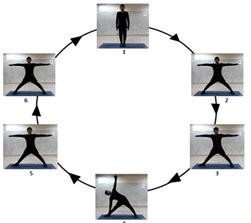A group of scientists at the Indian Institute of Science (IISc), Bangalore have found a method to measure whether the Yogic asanas is being performed in a correct manner or not. They have developed a new mathematical metrics to quantify the expertise in terms of stability and steadiness. The metrics is based on sEMG or Surface electromyography (sEMG) signals. The sEMG signals are a measure of muscle activity which records and differentiates between the electric activity of groups of muscles at rest and during activity.
The procedure is performed using a single or an array of electrodes placed on the skin surface over the muscles to be tested. Recording can be made using a hand-held device, which is applied to the skin surface at different sites. Electrical activity is assessed by computer analysis of the frequency spectrum, amplitude, or root mean square of the electrical action potential. In the IISC study the data captured from instrument called 3-axis Accelerometers is being used in qualitative validation of the muscle activity results obtained from proposed sEMG analysis.
The study supported by Department of Science & Technology (DST), SATYAM programme was performed in Biomechanics Lab, Indian Institute of Science (IISc), Bangalore. Around 60 healthy participants between 21 – 60 years including male and female were tested. Before conducting the experiment, each subject was given clear knowledge about the asana to be performed and the orientation was verified before mounting the sensors. The data was collected for approximately 110 seconds and subjects stayed in final position for 20 seconds with normal breathing and relaxed mind. Yogasanas such as Trikonasana, Vrikshasana, Veerabhadrasana-1, Veerabhadrasana-2, Veerabhadrasana-3, Parsvakonasana were tested using the method and the sEMGs of experts and novices tested.
Yoga asanas need to be performed with near perfection in order to derive maximum benefits. The method proposed and tested in this project helps assess the correctness of performance. This paves way for making appropriate corrections, thus enabling practitioners to derive maximum benefit from the asanas. The method helps distinguish between an expert and a novice in the field of yoga. With subsequent research and analysis, this method can be used for generating a quantitative measure of the 'expertise' of any subject being monitored, which would be essential considering the increasing popularity of yoga around the world. The study will guide the performer of yoga to do it with near perfection and also will elucidate the kinds of muscles that the performer can target.
The Science and Technology of Yoga and Meditation (STYAM) programme of the DST supported sixteen Projects in the year 2018-19. These projects will explore different dynamics of yoga and meditation on human body, mind and consciousness. Some studies will analyse effect of yoga on diabetes, Parkinson’s disease, motor function, schizophrenia and mild cognitive impairment. Yoga intervention will be given to elderly for better balance. Efficacy of Iyengar yoga will be studied to improve muscle functions and gait characteristics in children with cerebral palsy. In one project brain activity during audio guided meditation will be mapped using fMRI. In other project efficacy of yoga based intervention for opioid dependence will be checked.
Such studies can be very effective in establishing the science behind the benefits derived from traditional wellness methods like Yoga and Meditation.
Fig: Sensor position and orientation of EMG sensor placement using adhesive

tape


Fig: Schematic representation of the location of sEMG and ACC sensors, where X and Y represent the axis direction of accelerometer. Z axis is into plane of paper and Steps involved

Fig: Plug-In-Gait marker set

Fig: Gait cycle of Performing Trikonasana with OptiTrack Suit






























